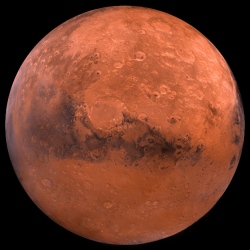
Above the surface of Mars’s sunlit side, protons of the solar wind begin to smash into the upper reaches of Mars’s atmosphere. NASA’s MAVEN spacecraft, which arrived at the Red Planet in 2014, has detected mysterious beams of oxygen ions flowing away from the planet, across the solar wind or even directly against it.
Scientists have hotly debated how these counterstreaming beams form. Masunaga et al. analyzed data from the MAVEN spacecraft. They found four examples of these fast beams of oxygen ions cutting through the solar wind upstream of Mars. By studying the velocity distributions of the ions, the team determined that they were carrying too much speed to have originated directly from Mars itself. Instead, oxygen atoms in the extended exosphere are ionized before they reach Mars, streak in with the solar wind, and are then repelled back outward at speed.
However, unlike suggestions from previous studies of solar wind protons, the authors found that it isn’t the bow shock, the shock wave that forms as the solar wind washes around the planet, like the waves off a ship’s bow, that reflects these oxygen ions back into space; instead, it’s the magnetic and electric fields that surround Mars. The team’s analysis shows that the oxygen ions penetrate the bow shock, but as they sink toward the surface of the planet, the piled-up magnetic and electric fields cause them to turn 180° and fling them back out into the solar wind, possibly even escaping Mars.
To follow up, the team plans to investigate how the ion streams react to variations in the solar wind, which is responsible for inducing those magnetic and electric fields. In addition, unlike Earth, Mars does not have an intrinsic magnetic field, but the rocks in its crust are strongly magnetized in a disorganized fashion. The team also plans to investigate how these locally intensified magnetic fields affect these ion beams.
